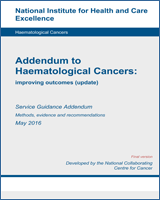NCBI Bookshelf. A service of the National Library of Medicine, National Institutes of Health.
National Collaborating Centre for Cancer (UK). Addendum to Haematological Cancers: improving outcomes (update). London: National Institute for Health and Care Excellence (NICE); 2016 May.
Haematological malignancies are a diverse group of cancers that affect the blood, bone marrow, and lymphatic systems. Some forms are highly aggressive, and others are so indolent that they are often only discovered by chance. Symptoms may include:
- lumps caused by enlarged lymph nodes, which are characteristic of lymphomas
- bone fractures and kidney disease/failure, which are characteristic of myeloma
- fatigue and vulnerability to infection and bleeding, which can be caused by most types of haematological cancer but are particularly severe in acute leukaemia.
The main categories of haematological cancer are lymphoma, myeloma, leukaemia, myelodysplastic syndromes and myeloproliferative neoplasms. These categories vary in prevalence, incidence and survival rates. In addition, there are subtypes of lymphoma and leukaemia, as well as rarer haematological cancers that have their own categories.
There are also borderline conditions such as aplastic anaemia and other non-malignant bone marrow failure syndromes (which overlap with hypoplastic myelodysplastic syndrome) and lymphocyte and plasma cell proliferations (which overlap with lymphoma and myeloma) that need specialised facilities for diagnosis and treatment.
Different levels of service are needed to manage haematological cancers, depending on the particular cancer in question. Because of the increased complexity of care and changes in the levels of care from those specified in the 2003 NICE cancer service guidance on improving outcomes in haematological cancers, an update was needed.
There has been progressive and variable adoption of specialist integrated haematological malignancy diagnostic services (SIHMDS), aimed at improving diagnostic accuracy and expertise. Integrated diagnostic reports are well established in some centres but not everywhere. In addition, new diagnostic techniques have been developed since 2003. Because of all this, an update to the diagnostic and evaluation sections in the 2003 guidance was also needed.
- Fergus MacbethChair, Guideline committee
- John SnowdenClinical lead, Guideline committee
- Foreword - Addendum to Haematological CancersForeword - Addendum to Haematological Cancers
Your browsing activity is empty.
Activity recording is turned off.
See more...
